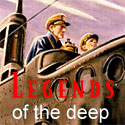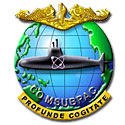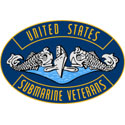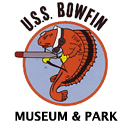Legends recently received this thorough commentary by Wahoo aficionado Chuck Thompson on the Kartashev video made during the Russian dives on Wahoo in July 2006. It gives a good breakdown on content of the video and the findings to be made through watching it. As it is lengthy, I will post it in segments. Thanks, Chuck!
USS WAHOO (SS-238), LOSS OF
COMMENTARY ON VIDEO
By
C. A. Thompson
The following is a commentary on the video taken by Russian divers on the wreck of the USS Wahoo (SS-238).
COMMENTS
1. The Wahoo sits upright on the bottom, with little if any list, at a reported depth of approximately 230 feet of seawater (fsw)
2. Visibility in the water, although a little dark, is good, approximately 40+ feet. There is considerable small, organic marine debris in the water, flowing with the current.
3. The current appears to be from the Port Quarter.
4. Rudder is amidships, bow and stern planes appear to be “straight and level”.
5. Limber holes are visible from aft of amidships to the stern, both Port and Starboard. They are “Government” pattern limber holes.
6. Marine growth covers most of the hull shown. Some of the “up current” side (port) is clear of marine growth, and corrosion in these clean area’s is minimum, except where entire panels are missing or there is obvious damage (To be discussed later).
7. The video is obviously edited. It jumps around, and in some spots leaves a sequence, only to pick the same sequence up again later.
8. Much expected video is missing. There is no video of the hull forward of the CTF, only the deck and bow plating (bullnose). There is no video of the area inside the bridge area, except from a distance and directly astern, and only darkness is seen. While there is close up video of the damaged area, it is difficult to interpret without easily identifiable reference points. The view of the area of primary damage is obstructed by a drawing of the damaged area.
9. While there is significant video of the periscope shears, there is no good video of the bridge.
10. Both periscopes appear to be fully raised. According to O’Kane (WAHOO), this was standard procedure in Wahoo’s conning tower when on the hunt for ships.
11. The SJ radar is facing directly to Port.
12. Missing decking and superstructure plating. There are several areas, mostly aft of the CTF, where decking/deck panels and vertical superstructure side plating is missing. This is particularly evident: (1) aft of the after deck 20mm mount (over the engine rooms), and (2) superstructure plating above ballast tanks on the port side, aft of the CTF damage. Some adjacent plating shows no indication of damage, and little evidence of corrosion. In all cases (except for the area of major damage amidships), supporting structure/frames are visible, and show no damage.
13. All visible hatches appear to be closed. While none of the hatches is clearly seen because of marine growth, none are in the fully open position, and all appear to be closed. The only hatch that is not visible in some video is the upper conning tower hatch. The closed hatches are substantial proof that none of the crew made any attempt to escape after the loss. This is puzzling as Wahoo is in only 230 fsw.
DAMAGE
1. The most obvious damage is in the area at the control room/after battery room bulkhead (frame 58), primarily on the starboard side.
a. A large section of the conning tower fairwater is missing, it appears to be from the two (port & starboard) fairwater access manways located just aft of the DF antenna, to about 5-8 feet from the end of the fairwater.
b. A small section of the aft end of the fairwater, though badly corroded, is still free standing.
c. On the starboard side, the major damage extends to the deck, the superstructure plating adjacent to the fairwater, and the ballast tanks, possibly all the way to at least the bilge keel (the lower hull in this area is visible only in the opening footage, and not very clearly).
d. On the port side, a section of decking and superstructure is missing, but the ballast tanks cannot be seen in any of the video provided.
e. It is probable that much of the superstructure/tank plating may have been damaged and distorted, but in place, immediately after Wahoo’s loss, but 60 years of storms and corrosion has caused it to fall away (metal which has been exposed to bending, such as an explosion, suffers minute cracking, loss of paint, and is easily corroded).
f. Damage to the pressure hull amidships, below the fairwater, is difficult to interpreted from the video provided. Examination of this area shows a jumble of debris. The Russian drawing seems to indicate that a large section of the pressure hull is missing, but the fact that debris is visible indicates that the pressure hull must still be there. This is not to say the pressure hull is not ruptured, as it most probably is, but that it is not completely destroyed, as the sketch seems to imply. All of the video showing this area has identifiable debris, so location can be established, but no actual penetrations of the pressure hull are identifiable.
g. Examining the damaged open end of the fairwater looking forward, one would expect to see the after end of the conning tower. While there is clear footage of this area, the after conning tower bulkhead cannot be distinguished. What is visible, extending atwartship from port to starboard, is what appears to be a ragged edge of plate just above the pressure hull. It is possible that the cigarette deck was blown (or collapsed) downward, and now covers the aft conning tower bulkhead.
i. There is no visible damage to the periscope shears, and this area is extensively photographed. The SJ antenna is intact, and the SD antenna shows only damage consistent with the fishing trawls covering the periscopes.
j. At the bridge (lookout) level, in a number of views, appears a large piece of wreckage which extends away from the bridge to starboard. No clear footage of this debris is available and it cannot be identified.
2. In the video provided, no significant damage is visible to the forward part of the boat. However, available footage shows only the main deck. Only a couple of deck plates, and possibly a tank manway cover are missing. The 4” gun is trained fore and aft, as it should be. The forward 20mm mount has been rotated, but this is likely the result of fishing trawls. There is no video of the hull forward of the conning tower, and as a result, any damage cannot be seen. There is no distortion in the forward deck to indicate that there may be serious damage to the hull.
3. There is lots of video of the hull aft of the conning tower fairwater. The hull, including propellers and shafts, both diving planes and the rudder, appear undamaged. However there is noticeable minor damage to the aft deck and superstructure in the form of missing deck plates and superstructure panels. One area immediately aft of the after 20mm mount (over the forward engine room) is missing deck plates from port to starboard, and adjacent vertical superstructure plating. However, the supporting framework for this decking/superstructure is visible and appears undamaged. There is also a significant section of vertical superstructure missing on the port side above the ballast tanks, extending from the damaged/missing area of the CTF, aft. In this area all the superstructure plating is corroded away, with the support structure visible and apparently undamaged. It is possible that the missing deck plates and hull panels are the result of the depth charging that Wahoo endured after she was sunk. Close depth charging may not cause rupture of the hull, or destroy deck and superstructure, but it can flex/bend plate and cause loss of paint, both of which would result in more rapid corrosion, and after 60+ years, these areas probably deteriorated (rusted) and fell away. This is illustrated in the vertical side and fairwater plating which shows just the corroded edges of plate, with most of the plate missing.
Part II will address sinking scenarios.
This Sounds Like It's From The Onion...
12 years ago








0 comments:
Post a Comment